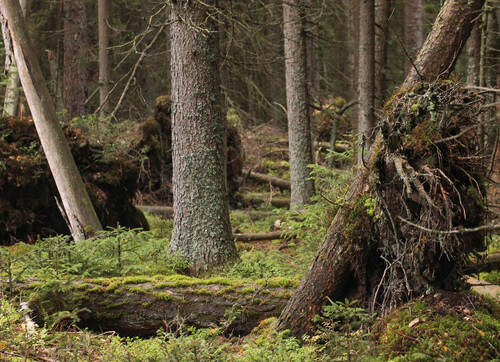Nature Conservation 2025 — 31. 7. 2025 — On Nature in the Czech Republic — Print article in pdf
Decaying Wood – A World of Wilderness
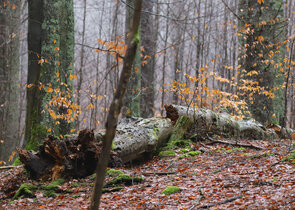
“Mess in the forest! Who has ever seen such a thing, leaving so much wood to rot uselessly!” Such words have been heard in the Šumava/Bohemian Forest Mts./Bohemian Forest Mts. for over thirty years. Fortunately, less and less frequently. Anyone who visits the Šumava/Bohemian Forest Mts. will certainly notice the striking amount of dead wood in the forests, tree rows, on the edges of fields or balks, and in abandoned meadows. Dead wood is primarily produced by nature, but in Specially Protected Areas in the Czech Republic it is also deliberately created by nature conservationists. Wood that has been cut into pieces or possibly debarked, shining in the green of the bilberry bushes, may not seem particularly conservation-oriented, yet it is worth considering why such wood is better than none at all.
Dead trees are part of the wilderness
Šumava/Bohemian Forest Mts.' Holocene nature has always been predominantly forested. And in the natural wild forest, wood not only grows but also dies; whole generations of trees grow and perish. Were it not for fungi and certain insect species that can break down cellulose, the Šumava/Bohemian Forest Mts. landscape would today be covered by several metres of dead trunks. In the past, it was almost like that in some places! Let us delve into the knowledge of those who experienced it: "Then we will also see hundreds, even thousands, of uprooted trees, their trunks lying here individually or in piled heaps, covered with moss and lichen, overgrown with clumps of heather and bilberry, and interconnected by myriads of roots and plant tendrils..." (Klostermann 1890). In the even older Joseph II's cadastre, we read that: "Here, one can see many fully grown and large trees, which actually only root in old, completely rotted windthrows. However, they do not reach the actual forest soil and are thus left to perish in all windstorms. And thus, one windthrow piles upon another, giving the impression of a wasteland, devoid of use and culture."
Water reservoir
For dried wood, which is not exposed to precipitation in the long-term, water constitutes about 12% of its weight. Višňová (2017) studied the dynamics of nutrient release from dead spruce wood on Mt. Trojmezná. Among other findings, she demonstrated that dead wood is a significant water reservoir. The still compact wood of recently dead Norway spruces (Picea abies), when most of the trunk is still covered in bark and a nail can be pressed in by hand to a depth of no more than 2 cm, has an average water content of 39%. At the next stage of decay, when the wood is partially decomposed and a nail can be pressed in up to 5 cm by hand, the water content is nearly 58%. Subsequently, wood that shows signs of complete decay and is soft is made up of more than 70% water. At this stage of decomposition, we even find trunks in which the water outweighs the dry matter. Based on experience from across the entire Šumava/Bohemian Forest Mts. National Park, most trees are found in the first two categories about 10 to 20 years after death. Most trunks, especially those lying on the ground and in vegetation, which have been dead for more than 20 years, fall into the "soft wood" category – and thus have a very high water content in their decaying tissue. The experiments carried out by Chromčák (2022), which monitored the ability of dead wood to gradually evaporate water as it dries, showed that even with about a month of no precipitation, while the outer edge of the wood dries to around 11% water content, the inner part of the wood retains around 25% water. He also found that wood 2 to 3 years after death has a moisture content ranging from 18% to 53%, depending on temperature and precipitation. Wood and water in the Šumava/Bohemian Forest Mts. form an inseparable pair – decaying wood continuously increases the water content, thus effectively enhancing water retention throughout the entire ecosystem. Unlike living trees, dead wood does not actively evaporate water, and thus transforms into life-giving biomass similar to soil.
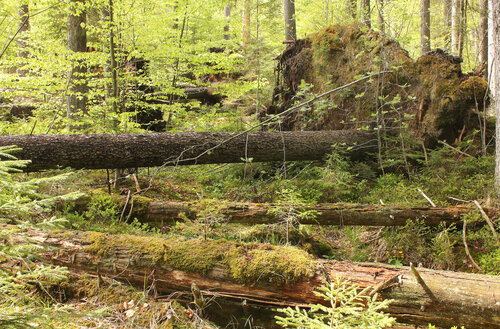
In the Boubín Primeval Forest, fallen trunks have been accumulating in layers over decades. © Pavel Hubený
Will it burn?
So far, it seems that the risk of fire, the development of which is accelerated by dead wood, is relatively low. The CzechGlobe FireRisk web project considers water content in dead wood below 15% to be a fire risk. As we can see from the moisture levels described above, such a risk is posed only by freshly dead wood, which is at most a few years old. Older dead wood can also be risky, but only after more than a month of exposure to drought. Such a situation is still relatively rare in the Šumava/Bohemian Forest Mts.; in 2023, it occurred only in August when, in some areas, water saturation dropped below 15% for an uninterrupted period of approx. 25 days. At most stations in the FireRisk network in the Šumava/Bohemian Forest Mts., it was mainly a case of short-term droughts lasting 5 to 10 days. It seems that soils behave in a similar manner to dead wood. Research by Šamonil (2023) indicates that, while soils with 50–80% skeleton content were more sensitive to water shortages, the majority of the assessed soils were highly water-retentive. The range of available water capacity in the profile was between 118 and 340 mm. This allows vegetation moisture requirements to be met for several tens of days in the absence of water supply, with approximately 40–60% of this capacity being allocated to the main root zone (to a depth of about 30–40 cm). It is true that the soil surface dries out more quickly during dry periods. However, if it is largely covered by dead wood, the risk of desiccation is reduced.
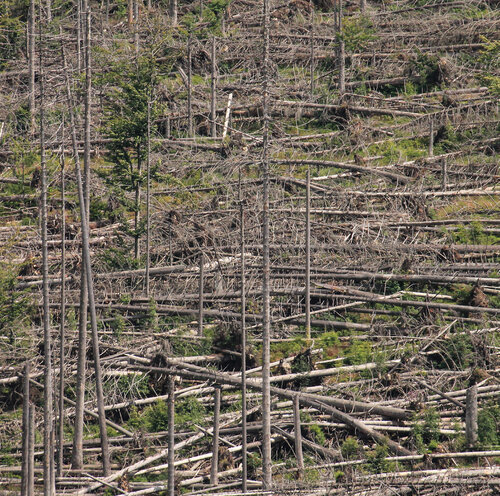
Drama in mountain spruce forests: windthrow and European spruce bark beetle. © Pavel Hubený
How much of it is lying there?
A ten-year measurement on permanent monitoring plots in a part of the National Park, where no management takes place and the forest is left to spontaneous development, revealed that, on average, there are 82 m³ of dead trunks of various dimensions per hectare. A more detailed analysis of the degree of waterlogging in their decayed parts, lying in the area for 20 to 25 years, showed that approximately 60% of their volume consists of water. Nearly 50 m³ of water per hectare! Around 70% of this water is fixed in the trunks, which appear as compact solid logs. The amount of water retained in the trunks increases with the extent of their decay. It is essentially influenced by the time that has passed since their death and the extent of contact with moist ground (Čížková 2016). If we try to imagine how much water the trunks of dead wood will retain in the same forests in another 20 years, we arrive at a value of around an additional 70 m³/ha.
In some forest stands, nearly the entire stand stock has died. More than 600 m³ of wood per hectare is gradually decaying. In a few decades, this volume will consist more of water than wood. The decaying wood provides a nutrient-rich environment for the development of organisms, will become a structure supporting the growth of new trees, and will protect the soil from drying out.
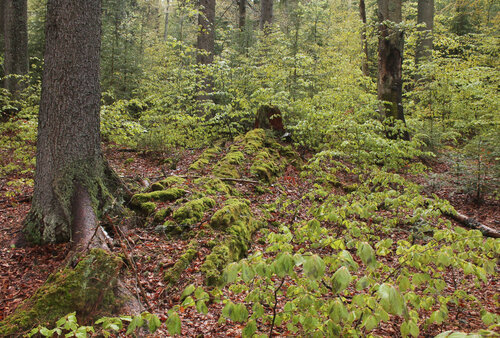
Trunks decay over decades. And they continue to affect the future of the local forest. © Pavel Hubený
The trunks prevent water runoff
In an area left undisturbed for 15–25 years after a European spruce bark beetle (Ips typograhus) outbreak, an average of 420 windthrow trees per hectare lie in various stages of decay. Around 150 trees per hectare form an obstacle to surface water runoff, meaning they lie roughly at contour level and are in full contact with the ground. The average length of such an obstacle is 4 m, and the average height is 33 cm. In approximately 55 obstacles per hectare, we observed an effect on vegetation change, in that it allows the growth of sphagnum mosses at the contact point between the ground and the obstacle. The effect of surface water retention there is thus long-term. In 40 obstacles per hectare, we observed a change in vegetation at the contact point between the trunk and the ground, favouring shade-loving forest species, such as the Hair moss (Polytrichum sp.), Greater wood-rush (Luzula sylvatica), and the Wood sorrel (Oxalis acetosella). More than half of the fallen trunks that slow down runoff directly affect the vegetation in their immediate vicinity, and more than a third of these fallen trunks clearly function as retention elements; small wetlands with sphagnum mosses are formed at the contact point between the obstacle and the ground (Čížková 2016).
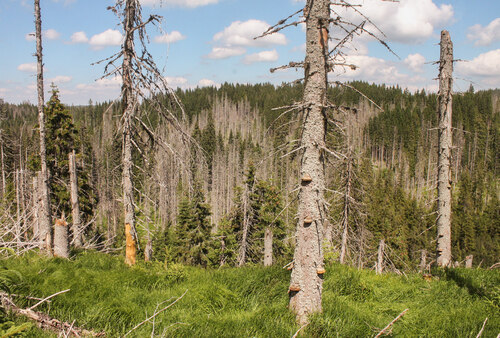
Red-belted brackets (Fomitopsis pinicola), stem-decay fungi, inhabit most of the bark beetle-damaged dry trees. © Pavel Hubený
A million barriers
When we restore peatbogs, we usually divide drainage channels into smaller sections with a large number of artificial dams, which are then filled with soil previously dug up. Dead wood does something similar on a vast area. Since no trunk stands forever, most dead trees eventually fall to the ground, and their trunks break into shorter sections. As decomposition progresses and the individual trunks and their fragments become heavier with the absorbed water, they increasingly submerge first into the vegetation, and later into the leaf litter and soil. On the ground surface, a network of structures forms of varying heights and water saturation, whose surfaces absorb and capture rainfall as well as melting snow. Subsequently, the number of small shadows and damp corners reduces evaporation and allows for greater water absorption throughout the entire ecosystem. Ultimately, this entire network becomes permeated by fungi, covered by lichens and mosses, creating a unique connection between living trees, vegetation, and the soil.
An age-old ecosystem is restored.
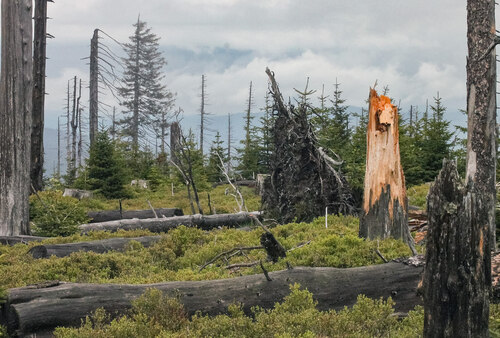
Many dead standing trees remain for more than two decades. © Pavel Hubený
Windthrow as a reservoir
At the end of the 19th century, Czech female writer Eliška Krásnohorská wrote about the Šumava/Bohemian Forest Mts. (Šubert 1895): “Uprooted trees lay about in chaotic heaps, forming marvellous pyramids, towers, and gateways here and there; elsewhere, an entire slope descending to the plain was covered by a wide, long band of pale-coloured wood, as if a torrent of fine ice shards were cascading down the hillside… An immense number of trunks have been burned, felled, and hauled away, as the vast, almost empty spaces bear witness. Yet in remote and inaccessible places, thousands of tree corpses still decay in their airy graves – some with their unearthed roots thrust skywards, others raising the skeletal remains of their crowns into the stormy winds that splinter and topple them, until at last they all lie flat, like those already around them, overgrown with lush lichen and ringed by bilberries.” After hurricane Kyril in 2007, many parts of the Šumava/Bohemian Forest Mts. looked much the same. Thousands of trunks lay piled atop one another in broad swathes; many were broken, but most had been uprooted. The slopes were darkened by a vast number of exposed root plates. And at that moment, a conservationist may have thought to themselves that the tractor ruts they had recently fined someone for were a mere trifle in comparison to this. But over time, we came to understand that there is a major difference between windthrow and tractor ruts. Under the wheels of heavy machinery, the soil becomes compacted, making life more difficult for soil microorganisms. Kilometres of tractor skid trails scarred the landscape and did, in fact, lead to its drainage. They always ran downslope, and over time their grooves turned into small streams, drawing water off the entire hillside. Windthrows, however, as it turned out, have quite the opposite effect. Their pools, often several metres wide, collect water, concentrate it, and allow it to infiltrate into the exposed soil and debris. It became clear that Šumava/Bohemian Forest Mts. forests are full of these depressions, and some of them date back as far as a thousand years. Based on analyses of windthrows from the Boubín Primeval Forest and other Šumava/Bohemian Forest Mts. sites, Phillips and Šamonil (2021) ultimately concluded that it is precisely windthrow dynamics that have a fundamental influence on soil formation and diversity, as well as on the differing infiltration of water into the subsoil. And all of this, in the end, leads to a different geomorphological development of the entire Šumava/Bohemian Forest Mts.mountain landscape, in which the spruce and its repeated uprooting are not only the drivers of high soil moisture but also creators of their own optimal living environment.
Uprooted trees gradually turn into piles of organic debris, altering both soil structure and terrain. © Pavel Hubený
Future soil
Dead trees gradually become part of the soil environment. This process usually takes several decades, depending on the size and species of the tree and on the character of the site. Undoubtedly, it also depends on the abundance of fungi present in the area. According to analyses by Vrška (2018), trunks in the Boubín Primeval Forest break down over a period of 55 to 90 years. However, fragmented tree trunks can, in some cases, survive for more than a century. In the Šumava/Bohemian Forest Mts., one can find remnants of wood beneath the stilted roots of spruce trees over a hundred years old, from which they originally grew. As the wood decays, nutrients that the tree absorbed during its life are gradually released. In spruce forests, approximately two hundred kilogrammes of calcium and around thirty kilogrammes of magnesium are fixed per hectare. As wood decomposes, the chemistry of the soils and the water running off it gradually changes. Probably due to the accumulation of dead wood in the Plešné Lake catchment area, after a period of strong acidification its aquatic environment restored faster than originally expected. Due to collaboration with fungi as dead wood continues to decompose, it accumulates additional nutrients from the surrounding environment, primarily nitrogen and phosphorus. In contrast, calcium, magnesium, and potassium decrease in the wood as it breaks down. These nutrients are consumed by other organisms throughout the ecosystem, with the most significant consumption occurring by the growing living trees.
Diversity
Decaying wood is a world of wilderness. Various stages of deadwood remain an integral part of Šumava/Bohemian Forest Mts. forests. In fact, it is mainly the presence of deadwood that evokes the true "impression of wilderness" in us. But it does not only affect us. I often hear that to achieve high species diversity it is better to have open land. However, this mainly concerns plants and insects. A wild forest full of dead wood also has high species diversity, especially in fungi and insects that depend on decaying wood. In the Boubín Primeval Forest, on just 47 hectares, hundreds of species of wood-decomposing fungi can be found, some of which are extremely rare. Without the long-term presence of a large number of decaying trunks in various stages of decomposition, we would not have such gems there as the bracket fungus Amylocystis lapponica, Phellinidium pouzarii, or Dentipratulum bialoviesense which was recently discovered by Jan Holec. A large number of dead spruces in the Šumava/Bohemian Forest Mts. National Park has enabled the rediscovery of the Large flat bark beetle (Peltis grossa) and confirmation of a large population of the longhorn beetle, the Hairy pine borer (Tragosoma depsarium). Without dead wood, these species would not have survived until today. And without a large amount of new dead wood, they might have soon become completely extinct in the Šumava/Bohemian Forest Mts.
And so, we can conclude with the words: Hail the dead trees! Hail the wilderness! ■
- - - -
Cover picture: Dying tree trunks are sources of life for the next generations of trees. © Pavel Hubený
- - - -
A list of references can be found at www.casopis.ochranaprirody.cz


